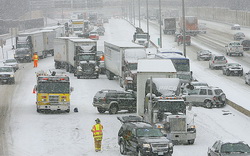
We all are familiar with the crawls on the TV screen or the announcements on the radio for winter weather advisories such as Winter Storm Watch, Blizzard Warning, Freeze Warning and more. But, how many of us really know what those mean? There is very specific criteria the National Weather Service follows in issuing these watches and warnings and there are important differences between all of them.
In this second in a series on Winter Weather Preparedness from the National Weather Service, ThorntonWeather.com helps you understand what all of these mean so you can be better prepared.
| Part 1 | Winter travel safety |
| Part 2 | Watches…warnings…and advisories |
| Part 3 | High winds |
| Part 4 | Wind chill temperatures and hypothermia |
| Part 5 | Avalanche safety |
| Review | Winter Weather Preparedness Week review |
From the National Weather Service:
What does that warning mean?
The National Weather Service will inform you about critical weather with outlooks, watches, warnings and advisories. Do you know what they mean? Now is the time to find out during this Colorado winter preparedness week.
This list has the watch, warning and advisory criteria for Colorado east of the continental divide. Save this list throughout the winter.
Warning criteria west of the continental divide will be provided today by the Grand Junction office.
Heavy snow criteria for north central and northeast Colorado are as follows:
- For the mountains – 8 inches of snow accumulation in 12 hours or 12 or more inches in 24 hours.
- For the lower elevations – 6 inches of snow accumulation in 12 hours or 8 or more inches in 24 hours.
Winter weather watches and warnings
A winter storm watch is issued when winter storm conditions are possible within the next 12 to 48 hours but the timing intensity or occurrence may still be uncertain.
A winter storm warning is issued when heavy snow is occurring or will develop in the next 18 hours. The heavy snow may be accompanied by wind greater than 15 mph and blowing snow.
A blizzard watch is issued when blizzard conditions are possible in the next 12 to 24 hours.
A blizzard warning is issued when the following conditions are expected for at least 3 hours:
- Sustained winds of 35 mph or greater.
- Considerable falling and/or drifting snow lowering
- Visibilities to less than a quarter mile.
A blizzard warning is issued for the mountains for the conditions above but wind winds in excess of 50 mph at the higher elevations.
A wind chill watch is issued when wind chill warning criteria are possible in the next 12 to 24 hours.
A wind chill warning is issued for wind chills of at least minus 25 degrees at lower elevations and at least minus 35 degrees in the mountains.
A freeze watch is issued when freeze conditions are possible in the next 12 to 24 hours.
A freeze warning is issued during the growing season when widespread temperatures are expected to drop below 32 degrees.
A high wind watch is issued when high wind conditions are expected to develop in the next 12 to 36 hours. Sometimes it will be issued late in the first forecast period – 6 to 12 hours – if the potential for high wind exists but there is some uncertainty.
A high wind warning is issued:
- For the mountains and foothills when sustained wind speeds of 50 mph for at least 1 hour or gusts to at least 75 mph for any duration are anticipated.
- For the lower elevations when sustained wind speeds of 40 mph for at least 1 hour or gusts to at least 58 mph for any duration are anticipated.
A winter weather advisory is issued:
- When general snow accumulations are expected between 4 and 8 inches in 12 hours in the mountains and between 3 and 6 inches in 12 hours at lower elevations.
- When falling snow is accompanied by blowing snow to cause travel problems due to lower visibilities.
- When wind blown snow will occasionally reduce visibilities and create a hazard for travelers.
- For freezing drizzle or a mix of precipitation types such as snow and sleet that will impact travel conditions.
A dense fog advisory is issued when widespread fog will reduce visibilities to a 1/4 mile or less.
A wind chill advisory is issued when wind and temperature combine to produce wind chill values from minus 18 to minus 25 degrees.
A frost advisory is issued during the growing season when temperatures are expected to drop between 32 and 35 degrees on clear calm nights.
A blowing dust advisory is issued when blowing dust reduces visibilities to below a mile.
This week is Winter Weather Preparedness Week in Colorado. Public information statements will be issued throughout the week to give safety information and help you know how to respond when winter weather threatens.

Just wondering, what does the && mean at the end of every weather warning?
Matthew, I honestly don’t know. I suspect they are some sort of a signal that denotes the message is ready to transmit.